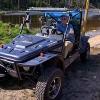TECHNICAL ARTICLES IN THIS FORUM
-
Similar Topics
-
By donny
Hey everyone new to forum I have a 2014 Odes raider and a 2009 Suzuki Ozark 250 both down atm 😔
-
By Alien10
I have a Coleman Outfitter 550 purchased in January 2022 that runs and operates pretty well. 65 hours on it so far. It is a work vehicle for my 10 hilly acres with two 1 acre woods and 5 acres of "lawn". The rest is under a lake.
My parking brake does not seem to have any grip. It worked when new but after a month or so, it is just almost useless. I press the parking brake pedal hard until it stops. Still, it won't hold even on slight inclines. I don't see the caliper move as I press the brake pedal down. There seems to be plenty of pad left on it and the rotor is shiny as if it is rubbing a little when applied, but not enough to stop it from rolling.
Any thoughts on possible causes?
-
By sister sweety
Thank you for adding me, I am the owner of a 2021 axis 700 UTV and also a 2023 Can-Am defender UTV
-
By ATRican
Just got a 2024 Odes Junglecross 800 cc four door 5 seater today. Feel free to share advice on longevity tips and common failures of this model.
AR
-
By great8redsfan
Okay folks. I have a low power issue. Been like this for a few years. Place I work at bought 3 and all have lost most of the pulling power. They gave them away after local shop worked on one for 3 months and it had great power for about 1 month and then crap. They replaced throttle body, fuel injector, spark plug and IAC motor. Seat belt switches have wires cut and left open so no seat belt warning light anymore. It revs to 6k rpm in neutral but when put in gear and take off in low it just doesn’t seem to want to go anymore. Running 93 octane fuel with Stabil. Any ideas greatly appreciated. I dont have a scan tool but no codes on dash. If held to floor it pops a little and runs almost 5K rpm but if I let off pedal about an inch it smoothed out and revs up to 6k rpm.
-








Recommended Posts
Join the conversation
You can post now and register later. If you have an account, sign in now to post with your account.
Note: Your post will require moderator approval before it will be visible.